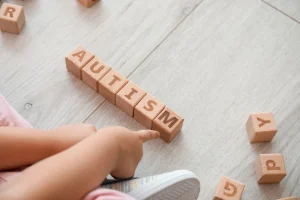Virtual Autism in Kids: What Parents Need to Know
By Rajini D
Last Updated: May 2, 2024
In today’s fast-paced digital world, a new challenge is catching the attention of parents and caregivers alike: the rise of virtual autism in kids. As technology becomes increasingly integrated into our daily lives, it’s no surprise that our children are more connected than ever before. But with this constant connectivity comes a concern that’s growing louder in the voices of experts and parents alike: the phenomenon known as virtual autism.
What exactly is virtual autism, you might ask? It’s a term that has emerged to describe a set of behaviors and symptoms in children that mimic those of Autism Spectrum Disorder (ASD), potentially triggered by excessive screen time and digital immersion. This doesn’t mean every child who enjoys their screen time is at risk, but it’s an eye-opening reminder of the balance we need to strive for in our digital lives.
What is Virtual Autism?

Imagine a world where screens become the primary interaction point for a child. Here, in this digital realm, virtual autism takes root. It’s a condition observed in young children who exhibit autism-like symptoms after spending excessive time engaged with screens. This isn’t about an occasional cartoon or a learning app session; it’s about prolonged, often unsupervised, screen time that replaces physical play, exploration, and face-to-face interactions.
Also Read: Virtual Autism in Kids: Signs, Causes and How to Help
Recognizing the Signs: Symptoms of Virtual Autism

As we continue to explore the nuances of virtual autism, it’s crucial for parents and caregivers to understand the signs and symptoms that may indicate a child is being impacted. Recognizing these symptoms early can lead to more effective management and intervention strategies. Let’s break down the behavioral, cognitive, and emotional signs in a way that’s easy to understand and relate to.
Behavioral Indicators
- Reduced Interest in Real-World Interactions: One of the first red flags might be a noticeable decrease in your child’s desire to play outside, engage in family activities, or participate in social gatherings with other children. Instead, they might show a strong preference for digital devices and virtual interactions.
- Frustration When Disconnected: Does your child become unusually upset or agitated when screen time is over? An intense reaction to being disconnected from digital devices could be a sign that their screen use is more than just a pastime.
- Changes in Play Patterns: Children with signs of virtual autism might prefer playing alone, using gadgets over interactive toys that encourage imaginative play or interaction with others.
Cognitive and Emotional Signs
- Social Isolation: If you notice your child withdrawing from family and friends, preferring to spend time alone with their screen, it could be a signal. While some solitude is normal and healthy, excessive isolation, especially in favor of digital interaction, warrants attention.
- Increased Depression and Anxiety: Keep an eye out for signs of sadness or worry that weren’t present before, particularly if these feelings intensify around discussions of screen time or after long periods spent on digital devices.
- Difficulty with Focus on Non-Screen Activities: Challenges in concentrating on homework, reading, or even following through with simple daily routines that don’t involve a screen could be symptomatic of a deeper issue.
Recognizing these signs doesn’t mean jumping to conclusions but rather observing and understanding your child’s behavior in the context of their digital device use. It’s about striking a balance and ensuring that our children reap the benefits of technology without it hindering their emotional or cognitive development.
Know more: Tech De-addiction | How to Put Off the Child from Gadgets? | How to Unplug My Kid?
The Impact of Virtual Autism
Delving deeper into the realm of virtual autism, it’s essential to understand the impact it can have on a child’s development, particularly in areas of social interaction and cognitive growth. These areas are fundamental to a child’s ability to navigate the world around them successfully.
Impact on Social Interaction
Imagine a scenario where a child, let’s call him Aryan, prefers to play his favorite video game over going to a friend’s birthday party. Initially, it might seem like a simple preference for digital entertainment. However, over time, Aryan starts to avoid all social gatherings, finding comfort only in front of the screen. This shift is one of the critical signs of virtual autism, where the ease of digital interactions starts to replace the complexity and richness of face-to-face communication. Aryan’s story reflects a growing trend where children find real-world interactions more challenging than their virtual counterparts. This reliance on digital forms of communication can hinder the development of vital social skills, including reading non-verbal cues, sharing, and empathy.
Cognitive Development Concerns
Now, consider another child, Bella, who used to love storytime. But recently, her parents have noticed her attention drifting after just a few minutes, longing to return to her tablet. This change in behavior points towards another significant impact of virtual autism – the effect on cognitive development. Essential skills like attention span, language development, and even problem-solving can be affected. For Bella, the immediate gratification and fast-paced stimuli provided by digital devices make the slower, more nuanced pace of real-world learning seem less appealing.
The Importance of Awareness and Intervention
Recognizing the impact of virtual autism is not about assigning blame to technology or suggesting that all screen time is detrimental. Instead, it’s about awareness and moderation. For Aryan, integrating structured social activities where he can interact with peers in a fun, pressure-free setting might help him rediscover the joy of personal connection. For Bella, setting aside specific times for reading and interactive learning activities away from the screen can rekindle her interest in storytime and enhance her concentration.
These examples highlight the critical importance of balance. It’s not about eliminating technology from our children’s lives but about ensuring that their exposure to digital devices supports rather than hinders their development. Awareness and timely intervention can make all the difference in helping children like Aryan and Bella thrive both online and offline.
Strategies for Management and Intervention
The role of parents and caregivers cannot be overstated. Managing screen time and fostering real-world interactions are pivotal in ensuring a balanced and healthy developmental environment for children. Here are some practical strategies tailored to various age groups designed to promote social skills and manage screen time effectively.
Tips for Young Kids and Preschoolers
- Make a No-Gadgets Spot: Pick places in your house where gadgets like tablets and phones are a no-go. This makes sure kids play more and chat more. Good spots are where you eat meals together or their rooms at bedtime.
- Set Screen Time Rules: Decide how long your child can use screens every day, like 30 minutes to 1 hour, and stick to it. Use a timer to let them know when screen time is over. It’s a simple way to make it part of their daily play.
- Play Together Without Screens: Spend time playing with your child with toys that don’t need screens. Things like jigsaw puzzles, building blocks, and board games are great. They help your child’s imagination grow and get you both talking and playing together.
For School-Aged Children
- Make Time for No-Screen Fun: Pick certain times in the day or week when everyone in the family does fun things without looking at screens. This can be playing outside, reading books, or making art together.
- Try New Activities Together: Sign your kid up for fun classes or teams where they can make friends and move around. Dancing, playing sports, or drawing in an art class are all great choices.
- Talk About Using Screens Wisely: Chat with your child about why it’s good not to be on screens all the time. Help them learn to choose when to use gadgets on their own, showing them how to balance screen time with other fun stuff.
For Teenagers
- Be a Good Screen-Time Role Model: Remember, teenagers watch what you do. Show them how you balance your time on gadgets and doing other things. This helps them learn good habits from you.
- Talk About It: Chat about what too much screen time can do, like making it hard to talk to people face-to-face. Ask them how they feel after spending a lot of time online and listen to what they say about their online world and friends.
- Teach Smart Online Choices: Help them understand why picking good things to watch or read online matters and how to stay safe. Knowing this helps them make smarter decisions when they’re online.
Wellness Hub Resources and Support
At Wellness Hub, we understand the intricacies of parenting in the digital age and offer a treasure trove of resources and support for those navigating the challenges of virtual autism. Our platform provides expert articles, guidelines, and personalized advice to help parents and caregivers foster a healthy digital environment for their children.
Explore more on our article Best Online Speech Therapy in Hyderabad
Preventing Virtual Autism
The digital world is here to stay, and it brings a wealth of knowledge and opportunities for connection. However, guiding our children to navigate this landscape healthily and productively is paramount. Let’s chat about some preventive measures that can help ensure technology serves as a tool for growth, rather than a barrier.
Setting Screen Time Limits
It starts with setting boundaries. Just like any aspect of parenting, consistency, and clear expectations are key. Screen time limits should be flexible enough to accommodate educational needs but firm enough to encourage other forms of play and learning. For example, toddlers might have 30 minutes of screen time a day, while older children might have up to two hours. Remember, these guidelines aren’t just about limiting; they’re about creating space for other enriching activities.
Encouraging Offline Activities and Interactions
The real magic happens off-screen. Encouraging offline activities—be it sports, reading, crafting, or just playing outside—helps children develop physically, mentally, and socially. Why not replace a movie night with a family game night? Or swap some video game time for a trip to the local park or library? These activities not only build skills and interests but also foster family bonds and friendships.
Read more about Engaging Home-Based Occupational Therapy Activities for Children with Autism
A Balanced Approach to Technology Use
Finding balance is crucial. It’s about ensuring that technology use is intentional and meaningful rather than habitual. Discuss with your child why they enjoy certain apps or games. What are they learning? How does it make them feel? Encouraging critical thinking about digital consumption can empower children to make smarter choices about how they spend their time online.
Engaging with Your Child Beyond the Screen
In a world where screens often dominate our attention, finding ways to connect with your child beyond digital devices is more important than ever. Engaging with your child in activities that don’t involve screens can significantly enhance your bond and promote their healthy development. Here are some simple yet effective tips to help you cultivate a deeper connection with your child, encouraging moments that you’ll both treasure.
Explore the Great Outdoors Together
Nature is one of the best playgrounds and classrooms. Take your child on a nature walk, go for a bike ride, or simply explore a local park. Discuss the plants, animals, and everything you see. It’s a fantastic way to teach them about the environment while fostering a love for the outdoors.
Get Creative with Arts and Crafts
Dust off the art supplies and get those creative juices flowing. Whether it’s painting, drawing, or crafting, working on an art project together can be incredibly bonding. It encourages creativity and provides a tangible reminder of your time spent together.
Cook or Bake Together
Invite your child to help you in the kitchen. Cooking or baking together not only teaches them valuable life skills but also involves following directions, measuring, and the joy of creating something delicious. Plus, it’s a great opportunity to talk, laugh, and make memories.
Read Together
Dedicate time each day to read with your child. For younger children, picture books are fantastic. As they grow older, they dive into chapter books or explore topics of interest together. Reading not only helps develop their language skills but also opens up discussions about different stories and subjects.
Play Board Games or Puzzles
Board games and puzzles are excellent for problem-solving and strategic thinking. Choose games appropriate for their age and get the whole family involved. It’s a fun way to spend quality time together while encouraging them to think critically.
Engage in Physical Activities
Whether it’s playing a sport, dancing, or simply playing tag, physical activities are great for their health and your connection. It teaches them the importance of staying active while you both have fun and burn off some energy.
Volunteer Together
Volunteering for a cause can be a powerful way to bond. It teaches compassion, empathy, and the value of giving back to the community. Choose a cause you both care about and find ways to contribute together.
Plan a “No Screen Day”
Designate one day a week or month as a “no screen day” to encourage offline activities. Use this time to explore new hobbies, visit a museum, or simply enjoy each other’s company. It’s a gentle reminder of the joy found in the world beyond screens.
Offline Activity Ideas by Age Group
| Age Group | Activity Ideas | Benefits |
|---|---|---|
| Under 2 years | Tummy time, stacking blocks, interactive storytime | Develops motor skills, encourages early language learning, enhances bonding |
| 2-4 years | Playdough, finger painting, simple puzzles | Fosters creativity, improves fine motor skills, problem-solving |
| 5-10 years | Nature walks, bicycle rides, DIY crafts | Promotes physical health, environmental awareness, creativity, and independence |
| 11-13 years | Reading clubs, model building, sports | Supports literacy and comprehension, teaches patience and focus, teamwork |
| 14-18 years | Volunteering, cooking projects, music or art classes | Builds social responsibility, life skills, self-expression, and confidence |
Conclusion
As we wrap up, it’s clear that balancing our kids’ screen time is crucial. We’ve learned a lot about virtual autism, how to spot it, and how it affects our kids’ social skills and learning. Most importantly, we’ve talked about ways to help, like setting screen time limits and finding fun offline activities. This isn’t just about cutting down on screen time; it’s about making sure our kids grow up healthy and happy, with a good mix of online and real-world experiences.
Wellness Hub is here to help parents like you. We’ve got lots of tips and advice on managing screen time and keeping a healthy balance in our digital world. Remember, with the right approach, our kids can enjoy the best of both worlds, learning and having fun online while still enjoying all the great things the real world has to offer. Check out Wellness Hub for more ideas on how to make this happen.
Frequently Asked Questions:
1. What is virtual autism in children?
Virtual autism refers to behaviors and symptoms in children that resemble those of Autism Spectrum Disorder (ASD), potentially caused by excessive screen time. Unlike ASD, these symptoms may decrease when digital device use is reduced.
2. How can I tell if my child is affected by virtual autism?
Signs include a noticeable decrease in interest in real-world interactions, frustration or agitation when screen time is limited, social withdrawal, and changes in attention span and language development. Observing your child’s behavior in relation to their screen use is key.
3. What impact does virtual autism have on a child?
Virtual autism can affect a child’s social interactions, making face-to-face communication challenging. It may also impact cognitive development, affecting attention span, language development, and problem-solving skills.
4. Are there strategies to prevent virtual autism?
Yes, preventive measures include setting age-appropriate screen time limits, encouraging offline activities, and fostering a balanced approach to technology use. Engaging in outdoor activities, reading, and other non-digital interactions are also beneficial.
5. How can parents manage their children’s screen time effectively?
Parents can manage screen time by creating tech-free zones, establishing clear screen time rules, engaging in family activities that don’t involve screens, and using parental controls on digital devices. Additionally, educating children about the importance of balance in digital consumption is crucial.
6. Can screen time be beneficial for children?
Yes, when used appropriately, screen time can be educational and support learning, creativity, and social connections. The key is moderation and ensuring digital interactions are meaningful and complemented by ample offline experiences.
7. Where can I find more resources and support on managing virtual autism and promoting digital wellness?
Wellness Hub offers a variety of resources, including articles, interactive tools, and expert advice on managing screen time and fostering a balanced digital lifestyle for families. Visit Wellness Hub for more information and support.
8. How much screen time is recommended for children?
Recommended screen time varies by age. For toddlers aged 2-5, no more than one hour of quality screen time per day is suggested. For children and teens aged six and older, parents should place consistent limits on screen time, ensuring it does not interfere with adequate sleep, physical activity, and other behaviors essential to health.
9. What are some offline activities to help reduce screen time?
Engaging in outdoor activities like hiking, cycling, or playing sports can significantly reduce screen time. Indoors, consider board games, puzzle-solving, arts and crafts, cooking or baking together, and reading. These activities not only cut down screen time but also promote cognitive and physical development.
10. How can schools and educators contribute to managing virtual autism?
Schools and educators can play a vital role by incorporating lessons on digital literacy and the importance of a balanced digital life. Providing structured tech-free times during the school day and promoting extracurricular activities that encourage social interaction and physical activity are also effective strategies. Educators can also support parents by sharing observations about a child’s screen use and its potential impact on learning and social skills.
About the Author:
Rajini Darugupally
M.Sc., Speech-Language Pathologist (9+ years of experience)
Rajini is a passionate and dedicated Speech-Language Pathologist with over 9+ years of experience, specializing in both developmental speech and language disorders in children and rehabilitation in adults. Driven by a desire to empower each individual to find their voice, Rajini brings a wealth of experience and a warm, genuine approach to therapy.
Currently, at Wellness Hub, she thrives in a team environment that values innovation, compassion, and achieving results for their clients.
Connect with Rajini to learn more about how she can help you or your loved one find their voice
Book your Free Consultation Today
Parent/Caregiver Info:
Client’s Details:
* Error Message









